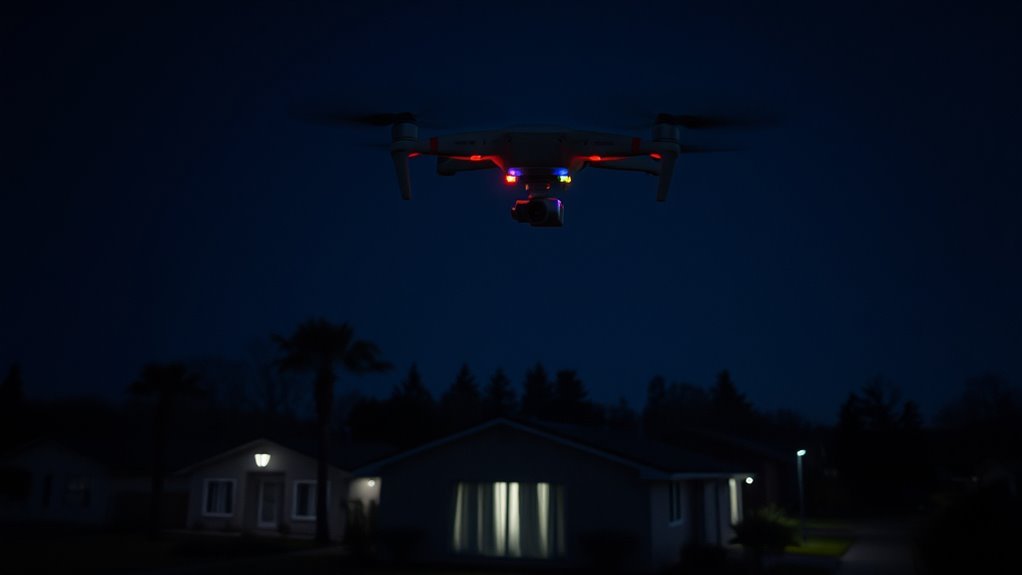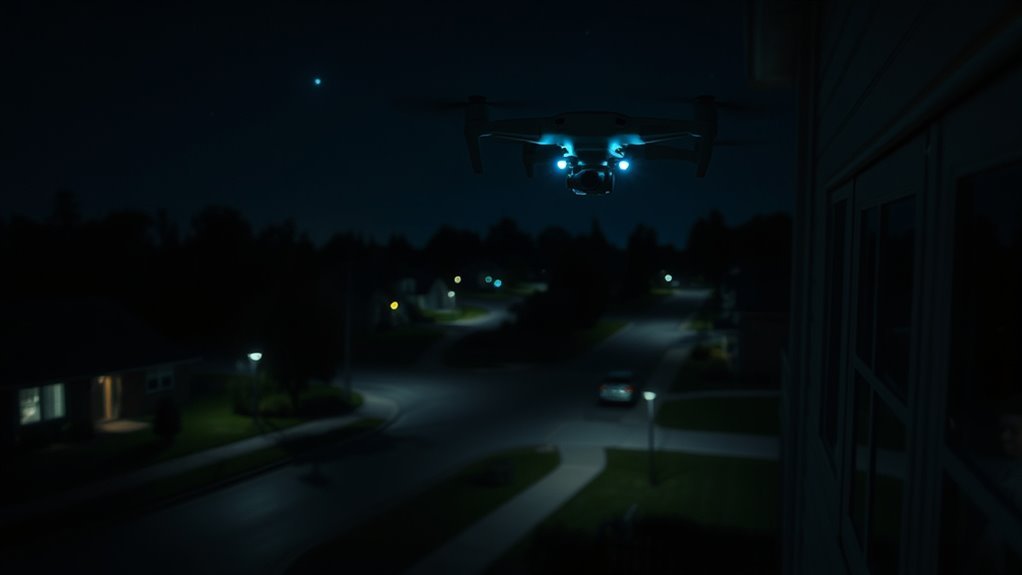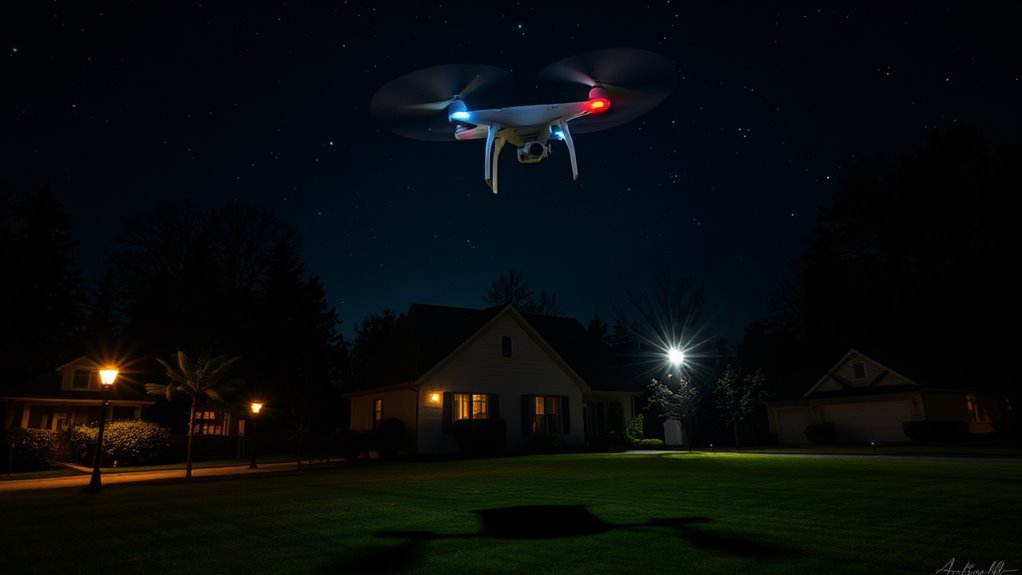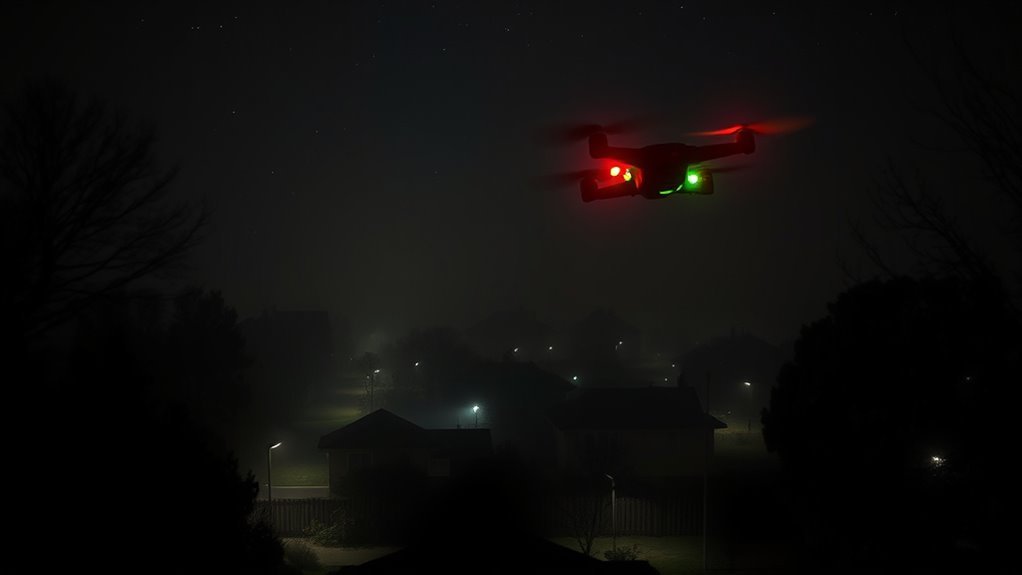Drones might be flying over your house at night for various reasons, such as surveillance, security monitoring, or even recreational activities. They can enhance safety by providing real-time footage of unusual behavior or assist emergency services with urgent responses. While these advancements offer benefits, they also raise privacy concerns that you might want to contemplate. Understanding the reasons behind their flights can empower you to address any issues and concerns effectively.
The Rise of Drone Technology

As drone technology continues to evolve, you may find yourself increasingly aware of their presence in everyday life. The recent drone advancements have revolutionized various sectors, from delivery services to agricultural monitoring. However, this rapid growth raises significant privacy implications that you should consider. With drones capable of capturing high-resolution images and videos, your personal space might be more exposed than ever. You might wonder who’s operating these devices and for what purpose. While drones can enhance efficiency and innovation, they also challenge your sense of security and autonomy. As a society, it’s vital to strike a balance between embracing technological benefits and protecting individual rights, ensuring that you maintain the freedom to enjoy your life without unwarranted intrusion. Furthermore, advancements in user control over flight data are essential in addressing privacy concerns and empowering individuals to manage their information effectively. Moreover, the integration of advanced sensor technology is crucial for ensuring that drones operate safely and responsibly in shared airspace, minimizing risks associated with their use.
Surveillance and Security Applications

Drones are increasingly being used for surveillance and security, enhancing home safety through real-time monitoring. You might notice their role in neighborhood watch programs, where communities collaborate to deter crime and increase vigilance. Furthermore, law enforcement agencies leverage drones for efficient patrols, gathering critical information without the need for extensive manpower. Additionally, the integration of advanced AI in drone technology allows for more effective threat detection and response, enhancing overall security measures. Drones like the Asylon DroneSentinel are designed with robust features that cater specifically to security operations, making them indispensable tools for modern surveillance efforts.
Enhanced Home Security
While many homeowners seek peace of mind, enhanced home security through drone surveillance offers a robust solution for monitoring properties. Drones equipped with high-definition cameras can provide real-time footage, ensuring you stay aware of any unusual activity around your home. Integrating drone technology with home automation systems enhances your ability to respond swiftly to potential threats. However, it’s essential to contemplate privacy issues that may arise with this technology. Balancing security and personal privacy is significant, as the line between protection and invasion can blur. By understanding these dynamics, you can make informed choices about using drones for your home security needs. Ultimately, drones can empower you to protect your freedom and enhance your sense of safety at home.
Neighborhood Watch Programs
Neighborhood watch programs can markedly enhance community security by fostering collaboration among residents. These initiatives encourage active participation, which can greatly improve neighborhood safety. When you engage with your neighbors, you create a vigilant community that looks out for one another.
- Strengthens relationships between residents
- Increases awareness of unusual activities
- Provides a platform for sharing safety tips
- Encourages reporting suspicious behavior
- Fosters a sense of belonging and community engagement
Law Enforcement Use
As law enforcement agencies increasingly adopt advanced technology, the use of drones for surveillance and security applications has become a significant topic of discussion. You’re likely aware that drones can enhance public safety by monitoring criminal activity and aiding in emergency responses. However, this technology raises important privacy concerns. Many worry that unchecked drone surveillance could infringe on individual freedoms, prompting calls for stricter drone legislation. Without clear regulations, the balance between security and privacy remains precarious. It is crucial to engage in conversations about how these tools are used, ensuring that they serve the public good without compromising your rights. Understanding these dynamics can help you navigate the complexities surrounding drones flying over your neighborhood at night.
Law Enforcement and Emergency Services

When drones are used in law enforcement and emergency services, they greatly enhance operational efficiency. From surveillance operations to search and rescue missions, these aerial tools provide real-time data that can be essential in critical situations. Additionally, drones can aid in crime scene monitoring, ensuring a thorough and accurate assessment without jeopardizing evidence integrity. Their advanced technology innovations offer precise navigation and real-time insights, empowering agencies to respond swiftly to emergencies. Drones equipped with real-time obstacle avoidance systems can navigate challenging terrains, ensuring that they reach their destinations safely and efficiently.
Surveillance Operations
Although it might seem unsettling to have drones hovering above your home at night, these aerial devices are increasingly utilized by law enforcement and emergency services for surveillance operations. While their primary goal is to enhance public safety, concerns about drone privacy can’t be ignored.
Here are some key points to take into account:
- Drones can monitor high-crime areas more effectively.
- They provide real-time data during emergencies.
- Aerial surveillance can help in locating suspects.
- Drones are often less intrusive than traditional methods.
- Transparency in usage is vital for community trust.
Understanding this balance between safety and privacy is essential as drone technology evolves. It’s important for communities to engage in discussions about regulations and the ethical use of such tools.
Search and Rescue
While the use of drones in search and rescue operations has revolutionized the way law enforcement and emergency services respond to crises, their effectiveness depends on real-time data and rapid deployment. Drone technology provides a unique advantage, allowing for aerial views that can cover vast areas quickly, making it easier to locate missing persons or assess disaster zones. In urgent search operations, the ability to deploy drones swiftly can mean the difference between life and death. Equipped with thermal imaging and high-resolution cameras, drones can identify heat signatures and navigate challenging terrains. This innovation not only enhances response times but also guarantees that resources are used efficiently, giving you greater confidence in the capabilities of emergency services when it matters most.
Crime Scene Monitoring
The application of drone technology extends beyond search and rescue, playing a significant role in crime scene monitoring for law enforcement. With their ability to provide real-time data and aerial views, drones enhance crime scene analysis and improve investigative efficiency. You may notice them flying overhead at night, ensuring safety in your community.
Here are some key benefits of drone use in crime scene monitoring:
- Rapid response to emergencies
- Enhanced visibility during nighttime surveillance
- Minimized footprint at crime scenes
- Improved data collection for investigators
- Cost-effective resource for law enforcement
Hobbyist and Recreational Use
As hobbyists embrace drones for recreational use, the nighttime sky often becomes a canvas for their aerial displays. Many enthusiasts engage in drone racing, a thrilling sport where speed and agility take center stage under the stars. This competitive aspect not only fosters community but also sparks innovation in drone technology. Additionally, aerial photography allows hobbyists to capture breathtaking nighttime landscapes, showcasing their skills and creativity. You may notice these drones buzzing overhead as participants refine their techniques or simply enjoy the freedom of flight. While these activities can be mesmerizing, it’s important to respect local regulations and be mindful of your neighbors. Ultimately, the rise of recreational drone use opens up new avenues for exploration and artistic expression. Moreover, the use of advanced technology in drones enhances their capabilities, enabling users to navigate complex maneuvers with ease. Many drones feature advanced stabilization technology that ensures steady flight even in windy conditions, contributing to the overall enjoyment of flying.
Agricultural Monitoring and Management
When farmers leverage drones for agricultural monitoring and management, they gain a powerful tool for enhancing crop health and efficiency. Drones provide precise data that helps you make informed decisions about your farming practices. By using drones, you can:
- Monitor crop health with multispectral imaging
- Conduct yield assessments to predict harvest outcomes
- Identify pest infestations early
- Optimize irrigation through aerial surveys
- Evaluate soil conditions and nutrient levels
This technology allows you to assess your fields quickly and accurately, reducing resource waste and maximizing productivity. Drones empower you to take control of your agricultural operations, ensuring sustainable practices while meeting the demands of a growing population. Embracing this innovation can lead to greater freedom in managing your farm effectively. Additionally, real-time data analysis enables farmers to respond swiftly to emerging challenges and optimize their operations. Furthermore, advanced stabilization technology in drones helps maintain image clarity during flight, enhancing monitoring accuracy.
Mapping and Surveying
Drones have revolutionized mapping and surveying, offering considerable advantages over traditional methods. With drone mapping, you can capture high-resolution images and data from angles and altitudes previously unattainable. This technology enables you to survey large areas quickly and accurately, greatly reducing time and labor costs. Aerial surveying with drones provides detailed topographical information, helping you make informed decisions about land use, construction, and environmental impact. Furthermore, the real-time data collection allows for immediate analysis, enhancing your ability to adapt to changing conditions. As you explore your options, consider how these innovations can empower you to take control of your projects, giving you the freedom to work more efficiently and effectively in your pursuits. Additionally, advanced sensor integration enhances precision mapping, ensuring that your collected data is both accurate and reliable. The sub-centimeter resolution of drones like the Wingtra One allows for even greater detail in your surveying tasks.
Delivery Services and Package Tracking
The advancements in drone technology extend beyond mapping and surveying, greatly impacting delivery services and package tracking. You might notice drones flying overhead, and they’re likely part of a new wave in logistics aimed at enhancing efficiency and speed in package delivery. With drone tracking, you can follow your package’s journey in real-time, providing a sense of control and transparency.
- Faster delivery times
- Reduced delivery costs
- Access to remote areas
- Lower carbon footprint
- Enhanced customer experience
As companies adopt these technologies, you can expect a transformative shift in how goods reach your doorstep, promoting convenience and freedom in your shopping choices. The future of package delivery is taking flight, quite literally! Additionally, drones like the Amazon MK30 are designed for optimized last-mile deliveries, enhancing the overall logistics experience. These innovations ensure that drones operate with advanced sensors that enhance reliability and safety during flights.
Film and Photography Opportunities
As you explore the world of film and photography, you’ll likely find that drone technology offers unprecedented opportunities for capturing stunning aerial shots and unique perspectives. Drones empower you to elevate your creativity, especially in nighttime cinematography where the interplay of artificial and natural light can create mesmerizing visuals. Imagine capturing cityscapes glittering under the stars or expansive landscapes bathed in moonlight, all from angles previously unattainable. Aerial photography allows you to tell compelling stories, showcasing the beauty of your environment in innovative ways. With intuitive controls and enhanced stability, drones are accessible to both professionals and enthusiasts. Additionally, the advanced stabilization algorithms found in drones like the DJI Matrice 600 help ensure smooth footage even in challenging conditions. Moreover, the 8K video resolution capabilities of drones like the Freefly Astro provide unparalleled detail, enhancing the overall cinematic quality of your projects. Embrace this freedom and let your imagination soar as you explore the rich possibilities that drones bring to your artistic endeavors.
Community Concerns and Regulations
While drones can enhance creative expression, they also raise significant community concerns and regulatory challenges. Many people worry about privacy, noise, and safety as these devices hover over residential areas. To address these issues, it’s essential to stay informed about drone regulations and promote community awareness.
Drones enhance creativity but also bring community concerns about privacy, noise, and safety that need addressing.
Consider the following points:
- Understand local laws regarding drone usage.
- Communicate with neighbors about drone activities.
- Report any suspicious or intrusive drone behavior.
- Advocate for community meetings to discuss drone regulations.
- Participate in local government discussions on drone policies.
Frequently Asked Questions
Are There Laws Against Flying Drones Over Residential Areas at Night?
Yes, there are drone regulations governing night flights over residential areas. You should check local laws and FAA guidelines, as many jurisdictions restrict or require permits for nighttime drone operations to guarantee public safety and privacy.
What Should I Do if I See a Drone Hovering Near My Home?
Have you ever felt uneasy seeing a drone hovering nearby? If you’re concerned about drone safety or privacy concerns, consider documenting the situation, checking local laws, and reporting it to authorities if necessary.
How Can I Identify Who Owns the Drone Flying Over My House?
To identify a drone’s owner, use drone identification methods like visual inspection or apps. Check local owner registration systems; many drone operators must register, providing you with valuable information about the operator’s identity and purpose.
Are Drones Equipped With Cameras Always Recording When Flying at Night?
Drones equipped with camera capabilities aren’t always recording during night surveillance. It depends on the operator’s intent and the drone’s settings. Some may capture footage, while others might simply be observing without recording anything.
Can I Report a Drone if It Disturbs My Peace at Night?
Yes, you can report a drone if its noise disrupts your peace. Document the disturbances and your privacy concerns, then contact local authorities. They can investigate potential violations of noise ordinances or privacy laws effectively.

